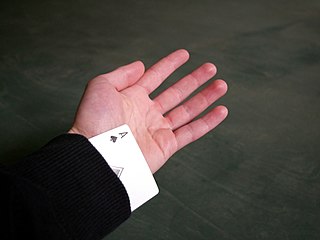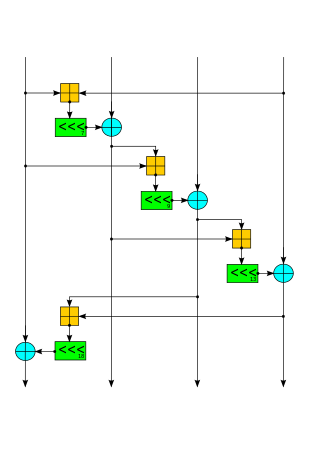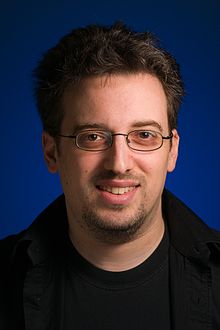In cryptography, key size or key length refers to the number of bits in a key used by a cryptographic algorithm.
Elliptic-curve cryptography (ECC) is an approach to public-key cryptography based on the algebraic structure of elliptic curves over finite fields. ECC allows smaller keys compared to non-EC cryptography to provide equivalent security.

Symmetric-key algorithms are algorithms for cryptography that use the same cryptographic keys for both the encryption of plaintext and the decryption of ciphertext. The keys may be identical, or there may be a simple transformation to go between the two keys. The keys, in practice, represent a shared secret between two or more parties that can be used to maintain a private information link. The requirement that both parties have access to the secret key is one of the main drawbacks of symmetric-key encryption, in comparison to public-key encryption. However, symmetric-key encryption algorithms are usually better for bulk encryption. With exception of the one-time pad they have a smaller key size, which means less storage space and faster transmission. Due to this, asymmetric-key encryption is often used to exchange the secret key for symmetric-key encryption.
Articles related to cryptography include:
In cryptography, the Elliptic Curve Digital Signature Algorithm (ECDSA) offers a variant of the Digital Signature Algorithm (DSA) which uses elliptic-curve cryptography.
NTRU is an open-source public-key cryptosystem that uses lattice-based cryptography to encrypt and decrypt data. It consists of two algorithms: NTRUEncrypt, which is used for encryption, and NTRUSign, which is used for digital signatures. Unlike other popular public-key cryptosystems, it is resistant to attacks using Shor's algorithm. NTRUEncrypt was patented, but it was placed in the public domain in 2017. NTRUSign is patented, but it can be used by software under the GPL.

In cryptography, nothing-up-my-sleeve numbers are any numbers which, by their construction, are above suspicion of hidden properties. They are used in creating cryptographic functions such as hashes and ciphers. These algorithms often need randomized constants for mixing or initialization purposes. The cryptographer may wish to pick these values in a way that demonstrates the constants were not selected for a nefarious purpose, for example, to create a backdoor to the algorithm. These fears can be allayed by using numbers created in a way that leaves little room for adjustment. An example would be the use of initial digits from the number π as the constants. Using digits of π millions of places after the decimal point would not be considered trustworthy because the algorithm designer might have selected that starting point because it created a secret weakness the designer could later exploit—though even with natural-seeming selections, enough entropy exists in the possible choices that the utility of these numbers has been questioned.

Salsa20 and the closely related ChaCha are stream ciphers developed by Daniel J. Bernstein. Salsa20, the original cipher, was designed in 2005, then later submitted to the eSTREAM European Union cryptographic validation process by Bernstein. ChaCha is a modification of Salsa20 published in 2008. It uses a new round function that increases diffusion and increases performance on some architectures.
In cryptography, Curve25519 is an elliptic curve used in elliptic-curve cryptography (ECC) offering 128 bits of security and designed for use with the Elliptic-curve Diffie–Hellman (ECDH) key agreement scheme. It is one of the fastest curves in ECC, and is not covered by any known patents. The reference implementation is public domain software.
Lattice-based cryptography is the generic term for constructions of cryptographic primitives that involve lattices, either in the construction itself or in the security proof. Lattice-based constructions support important standards of post-quantum cryptography. Unlike more widely used and known public-key schemes such as the RSA, Diffie-Hellman or elliptic-curve cryptosystems — which could, theoretically, be defeated using Shor's algorithm on a quantum computer — some lattice-based constructions appear to be resistant to attack by both classical and quantum computers. Furthermore, many lattice-based constructions are considered to be secure under the assumption that certain well-studied computational lattice problems cannot be solved efficiently.
DNSCurve is a proposed secure protocol for the Domain Name System (DNS), designed by Daniel J. Bernstein. It encrypts and authenticates DNS packets between resolvers and authoritative servers.
Mbed TLS is an implementation of the TLS and SSL protocols and the respective cryptographic algorithms and support code required. It is distributed under the Apache License version 2.0. Stated on the website is that Mbed TLS aims to be "easy to understand, use, integrate and expand".
Post-quantum cryptography (PQC), sometimes referred to as quantum-proof, quantum-safe, or quantum-resistant, is the development of cryptographic algorithms that are thought to be secure against a cryptanalytic attack by a quantum computer. The problem with popular algorithms currently used in the market is that their security relies on one of three hard mathematical problems: the integer factorization problem, the discrete logarithm problem or the elliptic-curve discrete logarithm problem. All of these problems could be easily solved on a sufficiently powerful quantum computer running Shor's algorithm or even faster and less demanding alternatives.
In public-key cryptography, Edwards-curve Digital Signature Algorithm (EdDSA) is a digital signature scheme using a variant of Schnorr signature based on twisted Edwards curves. It is designed to be faster than existing digital signature schemes without sacrificing security. It was developed by a team including Daniel J. Bernstein, Niels Duif, Tanja Lange, Peter Schwabe, and Bo-Yin Yang. The reference implementation is public-domain software.
NaCl is a public domain, high-speed software library for cryptography.
A Secure Shell fingerprint record is a type of resource record in the Domain Name System (DNS) which identifies SSH keys that are associated with a host name. The acquisition of an SSHFP record needs to be secured with a mechanism such as DNSSEC for a chain of trust to be established.
Post-Quantum Cryptography Standardization is a program and competition by NIST to update their standards to include post-quantum cryptography. It was announced at PQCrypto 2016. 23 signature schemes and 59 encryption/KEM schemes were submitted by the initial submission deadline at the end of 2017 of which 69 total were deemed complete and proper and participated in the first round. Seven of these, of which 3 are signature schemes, have advanced to the third round, which was announced on July 22, 2020.
In cryptography, Curve448 or Curve448-Goldilocks is an elliptic curve potentially offering 224 bits of security and designed for use with the elliptic-curve Diffie–Hellman (ECDH) key agreement scheme.
In cryptographic protocol design, cryptographic agility or crypto-agility is the ability to switch between multiple cryptographic primitives.
ChaCha20-Poly1305 is an authenticated encryption with additional data (AEAD) algorithm, that combines the ChaCha20 stream cipher with the Poly1305 message authentication code. Its usage in IETF protocols is standardized in RFC 8439. It has fast software performance, and without hardware acceleration, is usually faster than AES-GCM.



